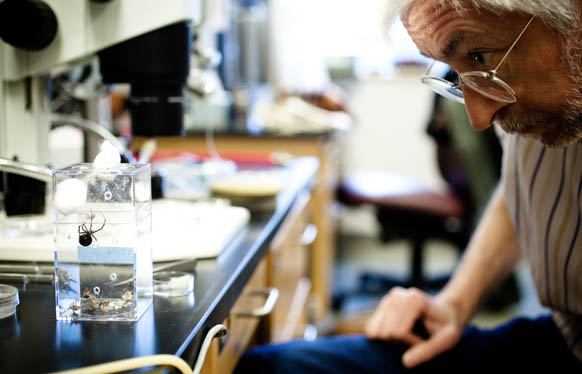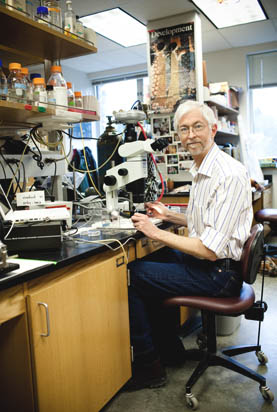
IRIS login | Reed College home Volume 90, No. 1: March 2011
Webmaster

HIS THOUGHTS EGGSACLY: Biology professor Steve Black examines how spiders confound the textbook view of embryonic development. Photos by Matt D'Annunzio
When his research hit a brick wall, Reed biology professor Steve Black didn’t flinch: he took a fresh look at a commonplace creature that does some pretty weird things with its eggs.
By David Frazee Johnson
They lurk in a back corner of the biology supply room, caged in clear plastic boxes: black widows with their telltale red hourglasses, brown recluses with their six eyes. Doomed crickets scurry back and forth in the cages as the spiders bide their time.
Reed biology professor Steve Black chuckles when asked about the fearsome reputation of his research subjects. “If someone would have told me 10 years ago that I’d have black widows and brown recluses in my lab, I would have told them that they’re out of their mind,” he laughs.
Black’s position as resident arachnophile is a relatively new role. He came to Reed from a postdoctoral position at Duke University in 1989, with an interest in the African clawed frog, Xenopus laevis. But after working with Xenopus for several years (including sending some up on a space shuttle flight), he began to have second thoughts. “It’s a wonderful animal,” he says. “But there are so many people out there working on Xenopus that it’s hard to find your niche. I figured I needed to work on something else.”
Black turned his attention to salamanders, in particular Ensatina eschscholtzii, a humble creature that makes its home in the Reed canyon. At first, the salamanders seemed like ideal research subjects, until Black and his students encountered one major obstacle: Ensatina lays its eggs in the late spring, a most inconvenient feature for thesis students needing embryos for their research.
Black winces as he recalls the strain this caused his students. “Each year, my thesis students would always be under stress, hoping for early egg laying, and it came down to the wire every time, and it just wasn’t healthy for anyone. I hated to let go of the salamanders,” he says, “but I slowly realized that I had to do it.”
Given the fundamental incompatibility between the life cycles of the Ensatina and the Reed biology senior, Black found himself at a professional crossroad. Then, in quintessential Reed fashion, his interest was piqued by a student. All her life, Crystal Chaw ’02 had been fascinated by spiders [See “Spider Woman,” Reed, November 2001]; she asked Black if she could pursue an independent research project on spider embryos. “They didn’t mean that much to me, honestly,” Black says. “I thought they wove beautiful webs, but that was about it.”
Black was doubtful; Crystal “begged and begged.” He finally relented. Then he took a look at the spider embryos for the first time—and what he saw changed his life.
![]()
In terms of their numerical diversity, spiders present a rich opportunity for research. Global species top 42,000, providing Black and his students with no shortage of candidates to test some of our most fundamental assumptions about developmental biology. “It’s considered a real bonus to have diversity of species,” Black says. “We can study spiders that are more evolutionarily derived, compare them with spiders whose traits are relatively ancestral, and learn more about the evolution of developmental pathways.”
With such astounding diversity, one might expect to find the scientific community teeming with experts in spider development. Not so. Including Black’s lab at Reed, there are three professional labs in the world devoted exclusively to spider development. In fact, Black notes, most of the research predates the 1950s, when scientific interest in the subject petered out.
The reasons for the abandonment of spider development are rooted in the rise of “model systems,” or animals that are easy to manipulate in the lab. Biologists believed that organisms such as fruit flies, mice, and zebrafish would provide enough diversity to account for different styles of development. Following World War II, Black says, “Model systems emerged very strongly, and people jumped on that bandwagon.” Easy to maintain and readily available, model systems were studied in the hopes that they would offer insight into the biology of less accessible species.
The trouble with model systems in biology, as in other disciplines, is that they can only provide a small part of the bigger picture. “While model systems are great, they don’t capture the variety and complexity of biological systems,” says Greta Binford, a professor of biology at Lewis & Clark College and an expert on spider biology. “For example, you have to go back somewhere between 400 and 500 million years to find a common ancestor to the arachnid and Drosophilia, which is a model system. That’s why it’s particularly helpful to see the work that Steve is doing.”
Black initially approached spiders with the assurance of someone who knows his way around the embryological petri dish. “After years of studying development, I’d like to think that I’ve got great intuition about it, but then I see these spiders, and realize that not everything works so simply.”
One of the paradoxes of evolution is that a characteristic or developmental process doesn’t have to be perfect, or even efficient, to be passed on. Any developmental solution that doesn’t kill the embryo can be seen as an evolutionary success. Spiders are a classic example; their embryos develop in ways that seem random, chaotic, haphazard, and just plain weird. Indeed, spiders confound the textbook view of embryo formation.



LATEST COMMENTS
steve-jobs-1976 I knew Steve Jobs when he was on the second floor of Quincy. (Fall...
Utnapishtim - 2 weeks ago
Prof. Mason Drukman [political science 1964–70] This is gold, pure gold. God bless, Prof. Drukman.
puredog - 1 month ago
virginia-davis-1965 Such a good friend & compatriot in the day of Satyricon...
czarchasm - 4 months ago
John Peara Baba 1990 John died of a broken heart from losing his mom and then his...
kodachrome - 7 months ago
Carol Sawyer 1962 Who wrote this obit? I'm writing something about Carol Sawyer...
MsLaurie Pepper - 8 months ago
William W. Wissman MAT 1969 ...and THREE sisters. Sabra, the oldest, Mary, the middle, and...
riclf - 10 months ago